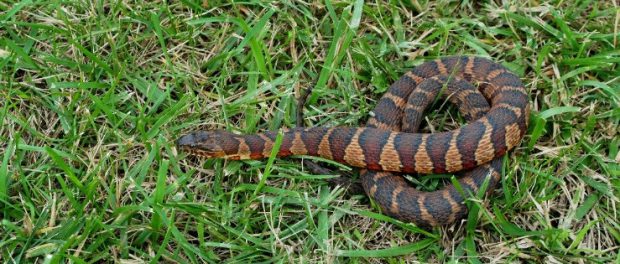
QUICK SUMMARY
- Multiple snake species call Fairfax County home.
- Snakes provide valuable pest control benefits.
- Learn how to identify species and reduce snake bite chances.
Fairfax County is home to an array of snake species, most of which are non-venomous and pose no threat to people (such as the Northern water snake pictured above).
Among the most frequently observed resident snakes are the Eastern rat snake, Eastern garter snake, Dekay’s brown snake, Northern water snake and Northern ring-necked snake; common and important predators in our ecosystems.
These snakes, and others, are beneficial and provide a valuable service in our communities in the way of pest control.
Take Note of the Eastern Copperhead Snake
The Eastern copperhead (formerly called the Northern copperhead) is the only venomous snake species commonly found in Fairfax County. Copperheads may be found basking in the sun on trails, in rocky areas and in stream valleys. They are most active between April and October. Copperheads can be identified by their:
- Triangular head shape
- Vertical pupil
- Hourglass scale pattern that runs the length of their body
- Copper, light brown or tan color
- Yellow-tip tails on juveniles
Many of our non-venomous snakes are unnecessarily killed each year because they are misidentified as copperheads. For information on identification of the Northern copperhead and harmless look-a-like species, please visit the Virginia Herpetological Society.
Northern copperheads, pictured above, are living in Fairfax County.
Click for larger image (left – adult copperhead; right – juvenile copperhead with yellow tail tip). Photos from the Virginia Herpetological Society.
When You’re Most Likely to Encounter Snakes
- When they are crossing roads
- When they are moving through your backyard or through other transient habitats
- During breeding season (spring or fall) when they are moving to look for mates
- When they are basking near habitat edges (e.g., water bodies, forest lines)
7 Tips to Reduce Your Chances of a Snake Bite
Most snake bites occur when snakes are handled or accidentally touched by someone walking or climbing. Following a few simple tips when outdoors can increase your chances of staying safe:
- If you see a snake, stop and keep a safe distance — give the snake room to move away on its own
- Do not try to handle snakes, as they may bite if provoked
- When walking or hiking, stay on trails, sidewalks and cleared pathways
- Wear boots or closed shoes and long pants when working outdoors or walking in wooded areas
- Wear leather gloves when handling brush and debris
- Use a flashlight if walking at night in areas where snakes might be present
- Keep dogs on leashes and pet cats indoors to reduce chances of them encountering a snake
3 Ways to Minimize Snakes Around Homes
Most snakes found around homes are following a food source or taking advantage of existing habitat. The following techniques should make your homes and premises less attractive and available for snakes.
- Remove favored habitat near the home, including heavy mulching and large rock used in landscaping, wood and brush piles, debris and high grass. Mow grass and keep it short. Trim trees and shrubs away from your home and garage and clear overhanging vegetation that snakes could climb. Move woodpiles away from the home.
- Remove favored food sources. Move birdfeeders away from the house or stop feeding altogether. Seed on the ground may attract rodents that snakes prey upon. Clean up any residual spilled seed on the ground to reduce their food source. Make sure to properly store and secure trash bins to avoid attracting rodents that snakes eat. Feed pets indoors. If feeding outside is necessary, be sure to cleanup uneaten food right away.
- Inspect your home for openings and seal cracks and crevices around the house and foundation. Check outside around water pipes, vents, electrical service entrances, doors and windows for small openings and under sidewalks and porches. A 1/4 inch hole is large enough for some small snakes to enter.
Who to Contact
If you find a sick or injured snake, contact the police non-emergency line at (703) 691-2131 to be connected with the Animal Protection Police.
If you are bitten by a snake you believe could be venomous, seek emergency medical attention immediately.
For more information on managing wildlife interactions and resolving human-wildlife conflicts, the Virginia Wildlife Conflict Helpline is available toll-free at (855) 571-9003, 8 a.m. to 4:30 p.m., Monday through Friday. This helpline is a collaborative effort between the Virginia Department of Game and Inland Fisheries and the U.S. Department of Agriculture – Wildlife Services.




 SIGN UP FOR DAILY EMAIL HEADLINES
SIGN UP FOR DAILY EMAIL HEADLINES